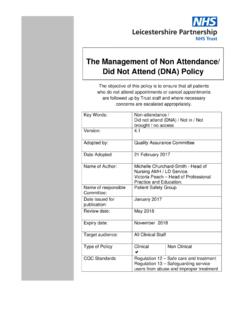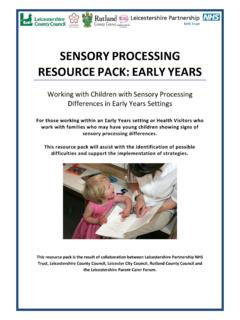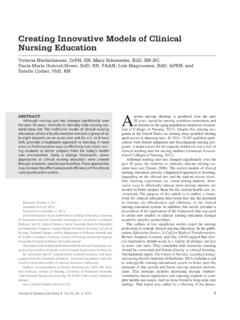Transcription of Clinical Strategy 2014 to 2019 (Refreshed in 2017)
1 1 Clinical Strategy 2014 to 2019 (Refreshed in 2017) 2 Summary The Clinical Strategy is the overarching Strategy for achieving the vision and the strategic objectives set by the Trust Board. The Clinical Strategy emphasises the need for right service models and a relentless focus on improving quality and productivity. It then sets out the principles for the right service models as well as key mechanisms for creating relentless focus on quality and productivity. Implementation of the Clinical Strategy is achieved through setting the direction for other strategies as well as driving our transformation programmes. A diagrammatic representation of this is shown as below: 3 Contents Section Content Page 1 Foreword (by Dr Peter Miller, CEO) 4 2 Introduction 5 3 Our Vision, Values and Strategic Objectives 6-7 4 National Strategic Context 9 5 Local Strategic Context 10 6 Challenges and Way Forward 10-12 7 LPT Clinical Strategy 12-14 8 Integrated Care 14-16 9 Prevention 16-18 10 Recovery Based Approaches 19-20 11 7 Day Working 20-21 12 Continuous Improvement 21-22 13 Self-Regulation 22-23 14 New Ways of Working 23-25 15 Information Management and Technology (IM&T) 26 16 Research and Innovation Supporting Improvement in Care Delivery 26-27 17 Whole Family Approach and Safeguarding 28 18 Enterprise Approach to Ensure Sustainability 29 19 What will be Different as a Result of this Strategy ?
2 29-30 20 Implementation of the Clinical Strategy 30 Appendix Content Page 1 Delivery and Oversight of the Clinical Strategy 31-32 2 Clinical Directorates 33 3 All-Age mental Health Transformation 34 4 References 35 4 1. Foreword The National Health Service (NHS), the world s largest publicly funded health service, continues to change rapidly and this presents many opportunities as well as challenges. To maximise the opportunities for the population of Leicester, Leicestershire and Rutland (LLR), we believe that we should develop a true partnership between the users of our service, their carers, the public, our front line staff and our partner organisations in driving a continuous improvement in the quality and cost effectiveness of the care we provide. This Clinical Strategy provides an overarching framework to make this happen. A key priority for our organisation is quality and a sustainable improvement in quality needs the following: Listening continuously to our users which include our service users, their families and carers Work in an integrated manner improving the coordination of care and delivery of services Our staff working together in teams to deliver the right care for our users at the right time and place Enhancing the power of front line clinicians to innovate and improve the care continually.
3 This Clinical Strategy sets the vision for the development of our services over the next five years. This will support the aspiration of our organisation to become an integrated community trust to improve the health and wellbeing of the population of LLR. Dr. Peter Miller Chief Executive 6 2. Introduction Leicestershire Partnership NHS Trust (LPT) provides high quality integrated mental health, learning disability and community care services. The Trust was created in 2002 to provide mental health, learning disability and substance misuse services. The Trust serves a diverse population of approximately one million people across LLR with residents having come from over 50 difference countries. The Trust has a budget in excess of 250 million and employs over 5,800 staff in a wide variety of roles. The Trust works with general practitioners (GPs), local hospitals, Social Services and other Local Authority departments such as housing and education.
4 We also work with voluntary organisations and local community groups. Our services are organised across three Clinical directorates: Adult Mental Health and Adult Learning Disability Services (AMHLD); Families, Young People and Children's Services (FYPC); and Community Health Services (CHS)1. Staff working with different members of the same family are increasingly creating networks across the directorates to support our whole family approach. We are also a teaching Trust, which means we proactively engage with and conduct research and provide training and education for medical, psychology, nursing and therapy students. This document sets out the Trust s Clinical Strategy for continually improving the quality and cost effectiveness of services, whilst ensuring we meet the health needs of the people of LLR. 3. Our Vision, Values and Strategic Objectives 1 See Appendix 1 7 Our vision is to improve the health and wellbeing of the people of LLR by providing high quality, integrated physical and mental health care pathways.
5 There are three key parts to this vision: Improve We believe that we are on a journey of continuous improvement to ensure that we consistently apply best practice and achieve outcomes comparable to the very best of our peers. An improvement focus will also enable us to achieve our financial targets and meet the needs of regulators and our health economy stakeholders. Leicester, Leicestershire & Rutland: We are part of the health and social care system in LLR and we play an important role in ensuring that people of LLR receive the best health and social care as possible to live healthy and independent lives. This ambition is captured in our Sustainability and Transformation Partnership Plans. Integrated Care Pathways: This might mean trying to transcend traditional boundaries between professional disciplines, mental and physical health as well as primary, secondary and social care. In all cases we will try to take a care pathway approach, moving from historic, fragmented and episodic models towards those that provide a seamless start to end journey for service users and their families.
6 Our vision statement defines who we are as a Trust and our staff work to a set of strong core values which are Respect, Compassion, Trust and Integrity. The Trust has four strategic objectives: 1. Quality Deliver safe, effective, patient centered care in the top 20% of our peers. 2. Partnerships Partner with others to deliver the right care in the right place at the right time. 3. Staff Staff will be proud to work here and we will attract and retain the best people. 4. Sustainability Ensure sustainability. 8 4. National Strategic Context NHS Five Year Forward View Aimed at addressing the three health gaps: Health and Wellbeing, Care and Quality, Funding and Efficiency: 1. Prevention with focus on obesity, smoking, alcohol and other major health risks. 2. Integrated approach across physical and mental health, primary and secondary care and health and social care. 3. Adoption of new care models that promote integration, prevention and sustainability.
7 Five Year Forward View for Mental Health Aimed at parity of mental health, prevention and early intervention 1. Improving access to high quality mental health care for children and young people. 2. Increased access to psychological therapies. 3. Improved access to mental health support for service users presenting in acute hospital settings. 4. Adult mental health services to provide timely access to evidence- based, person-centered care, which is focused on recovery and integrated with primary and social care and other sectors. 5. Prevent avoidable admissions and support recovery for people with severe mental health problems and significant risks/safety issues in the least restrictive setting as close to home as possible. 6. Improved care pathways across secure and detained settings. Transforming Care for People with Learning Disabilities Empowering people and families: 1. Choices and say for people and their families in their care; 2.
8 More care in the community, with personalised support provided by multi-disciplinary health and care teams 3. Innovative services to give people a range of care options, with personal budgets, meeting individuals needs 4. Intensive support earlier for those who need it, so that people can stay in the community, close to home; 5. Inpatient care when required is only for as long as it is needed. Future in Mind Making sure that children and young people have timely access to effective mental health care: 1. Emphasis on building resilience, promoting good mental health, prevention and early intervention 2. Improving access to the right care without barriers 3. Joined up care with care pathways which are easy to navigate. 9 5. Local Strategic Context The LLR Sustainability and Transformation Partnership General Principles of the LLR STP are as follows 1. To deliver high quality, person centered, integrated care pathways, delivered in the appropriate place and at the appropriate time by the appropriate person resulting in a reduction in the time spent avoidably in hospital.
9 2. To reduce inequalities in care (both physical and mental) across and within communities in LLR. 3. To improve the positive experience of care across all health and social care settings. 4. Ensuring care is provided in appropriate cost effective settings, reducing duplication and eliminating waste in the system. 5. Achieving financial stability. 6. To improve the utilisation of our workforce and the development of new capacity and capabilities where appropriate, in the people and the technology we use. The following work streams are in progress to achieve the above aims: A. New models of care focused on prevention and moderation of demand growth Home first Urgent and Emergency Care Integrated Teams Resilient Primary Care Planned Care B. Service Configuration to ensure Clinical and financial sustainability Acute Reconfiguration Maternity Services Community Hospitals C. Redesign pathways to improve quality of care and outcome Prevention Long Term Conditions Cancer Mental Health Learning Disabilities Children s, Maternity, Neonates Continuing Health Care and Personalisation Specialised Commissioning D.
10 Operational efficiencies through cost improvement, back office efficiencies and medicine optimization. E. Supporting the transformation with enablers such as IM&T, workforce and estates Transformation driven with Better Care Fund in LLR Leicester - Prevention, early detection and improvement of health- related quality of life, reducing the time spent in hospital avoidably and enabling independence following hospital care. Leicestershire - A unified prevention offer for local communities, better integrated and proactive care for those with long term conditions, integrated urgent response and better hospital discharge and re-ablement. Rutland Improved services even though there is greater demand and less money, having people cared for in their own homes with reduced lengths. 10 6. Challenges and Way Forward On one side the changes in population needs such as ageing and increase in demand for services for children and on the other side reduction in local authority and social care funding would challenge the sustainability of our existing service models.














